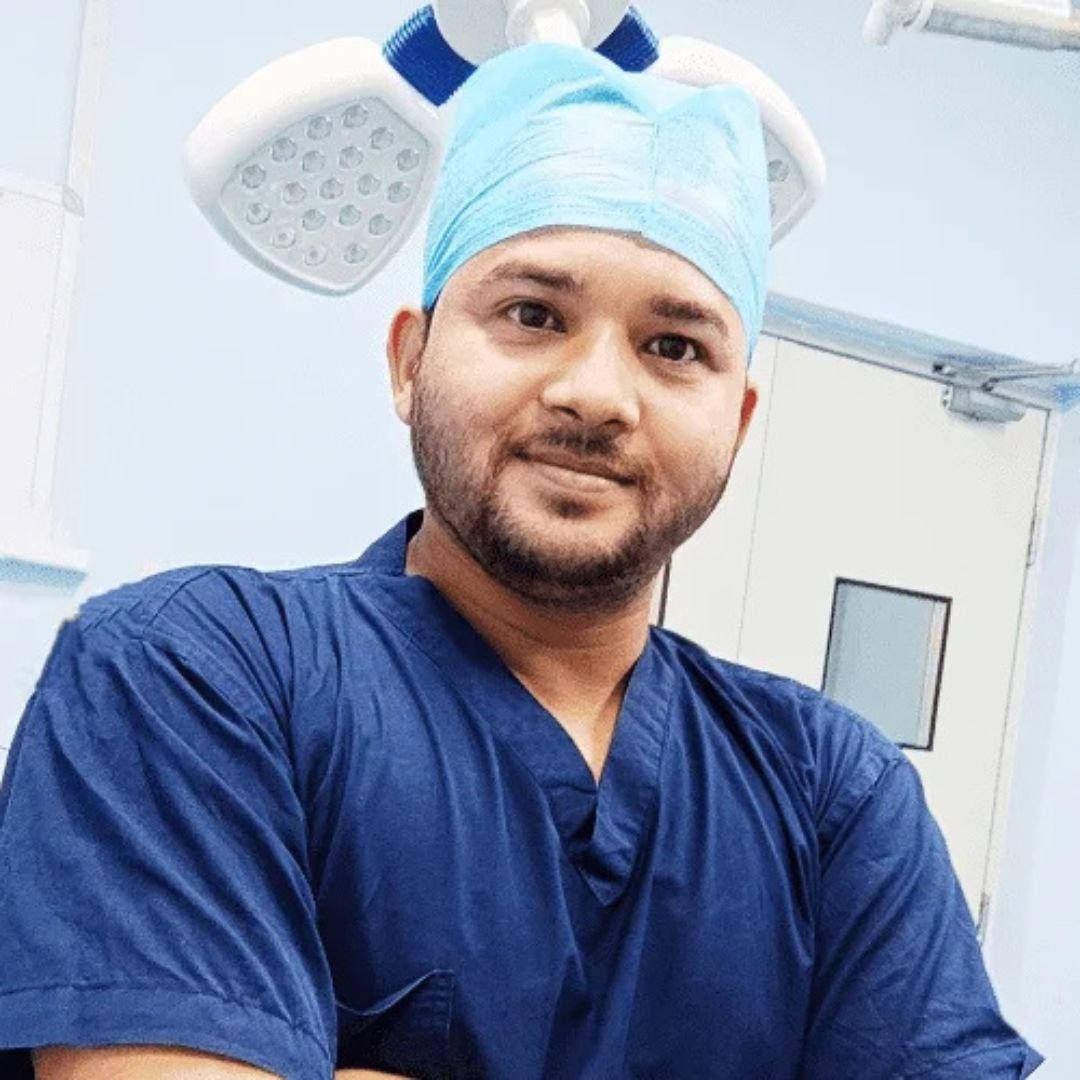Pilonidal Sinus Surgery - Risks, Benefits, & Treatments
Pilonidal sinus is a condition that affects the skin at the base of the tailbone, often causing pain, swelling, and infection. While it can be managed with pilonidal sinus home treatment in mild cases, severe or recurrent cases often require surgical intervention. Among the most advanced and effective treatments available today is laser treatment for pilonidal sinus, which offers a minimally invasive solution with faster recovery times.
At Bharatkare, we specialize in providing cutting-edge pilonidal sinus laser surgery and other treatment options tailored to your needs. Whether you’re exploring pilonidal sinus treatment without surgery or considering surgical options, our team of experts is here to guide you every step of the way.
Book Appointments With Our Expert Doctors Near You
- Get consultation for 50+ diseases across India
- In-person and online consultation with experienced doctors
- Extensive medical assistance throughout your treatment


Dr Ashish Sachdeva
MBBS, MS - General Surgery, General Surgeon, Bariatric Surgeon, Laparoscopic Surgeon
4.9/5
20 Years Experience
Vadodara, India

Dr. Tanmay Jain
General Surgeon, Laparoscopic Surgeon and Proctologist
4.9/5
12 Years Experience
Jaipur, India

Dr. Vikram Vasuniya
MBBS, MS (General Surgery) General Laparoscopic & Laser Surgeon, Laser Proctologist
4.9/5
14 Years Experience
Bhopal, India

Dr. Sujeet Kumar Bharti
MBBS, MS (General Surgery) General Laparoscopic & Laser Surgeon, Laser Proctologist
4.9/5
22 Years Experience
Patna, India
What is Pilonidal Sinus?
A pilonidal sinus is a small tunnel or cavity that forms in the skin, usually at the top of the buttocks near the tailbone. It often contains hair, debris, and fluid, which can lead to infection and abscess formation. The condition is more common in men and individuals who sit for prolonged periods, such as truck drivers or office workers.
The exact why pilonidal sinus occurs is not fully understood, but it is believed to be caused by a combination of factors, including ingrown hairs, friction, and poor hygiene. Some people may also have a genetic predisposition to developing this condition.
Symptoms of pilonidal sinus include pain, redness, swelling, and sometimes pus or blood drainage. If left untreated, it can lead to chronic infections and complications.
Disease name
Pilonidal Sinus
Surgery name
Endoscopic
Duration
15 to 20 Minutes
Treated by
General Surgeon
Laser Treatment for Pilonidal Sinus
Laser treatment for pilonidal sinus is a revolutionary approach that has transformed the way this condition is managed. Unlike traditional surgery, which involves cutting and removing the affected tissue, laser treatment uses focused light energy to precisely target and destroy the sinus tract.
The benefits of pilonidal sinus laser surgery include:
- Minimally Invasive: No large incisions are required, reducing the risk of scarring and infection.
- Faster Recovery: Patients can return to their daily activities much sooner compared to traditional surgery.
- Reduced Pain: Laser treatment is less painful, and post-operative discomfort is minimal.
- Lower Recurrence Rates: The precision of the laser ensures complete removal of the sinus tract, reducing the chances of recurrence.
At Bharatkare, our experienced surgeons use state-of-the-art laser technology to provide safe and effective pilonidal sinus laser surgery.
Pilonidal Sinus Surgery Cost
One of the most common questions patients have is about the pilonidal sinus surgery cost. The cost can vary depending on several factors, including the severity of the condition, the type of surgery performed, and the facility where the procedure is done.
While we don’t provide specific pricing details here, we encourage you to reach out to us for a personalized consultation. At Bharatkare, we believe in transparent pricing and will provide you with a detailed breakdown of the costs involved.
Pilonidal Sinus Home Treatment
For mild cases of pilonidal sinus, pilonidal sinus home treatment may be effective in managing symptoms and preventing complications. Some home remedies include:
- Warm Compresses: Applying a warm compress to the affected area can help reduce pain and swelling.
- Proper Hygiene: Keeping the area clean and dry is essential to prevent infection.
- Hair Removal: Regularly removing hair from the area can reduce the risk of ingrown hairs.
- Over-the-Counter Pain Relievers: Medications like ibuprofen can help alleviate pain and inflammation.
However, it’s important to note that pilonidal sinus home treatment is not a permanent solution and may not be effective for severe or recurrent cases. If your symptoms persist or worsen, it’s crucial to seek professional medical advice.
Difference Between Fistula and Pilonidal Sinus
Many people confuse pilonidal sinus with a fistula, but these are two distinct conditions. Understanding the difference between fistula and pilonidal sinus is important for accurate diagnosis and treatment.
- Pilonidal Sinus: This condition occurs at the top of the buttocks near the tailbone and is often caused by ingrown hairs. It typically affects young adults and is more common in men.
- Fistula: A fistula is an abnormal connection between two organs or between an organ and the skin. It can occur in various parts of the body, including the digestive tract, and is often caused by infection or inflammation.
While both conditions may require surgical intervention, the treatment approach differs based on the underlying cause and location.
Pilonidal Sinus Doctor Near Me
If you’re experiencing symptoms of pilonidal sinus, it’s essential to consult a specialist. Finding a pilonidal sinus doctor near me can be challenging, but at Bharatkare, we make it easy for you.
Our team of experienced surgeons specializes in the diagnosis and treatment of pilonidal sinus. We offer a range of treatment options, from pilonidal sinus treatment without surgery to advanced laser treatment for pilonidal sinus.
To find a pilonidal sinus doctor near me, simply visit our website or contact us directly. We’ll help you schedule a consultation with one of our experts.
Can Pilonidal Sinus Be Cured Without Surgery?
Many patients wonder, can pilonidal sinus be cured without surgery? The answer depends on the severity of the condition.
In mild cases, pilonidal sinus treatment without surgery may be effective. This can include antibiotics to treat infection, warm compresses to reduce swelling, and lifestyle changes to prevent recurrence.
However, for severe or recurrent cases, surgery is often necessary. Laser treatment for pilonidal sinus is a minimally invasive option that offers excellent results with minimal downtime.
At Bharatkare, we’ll assess your condition and recommend the best treatment plan for you.
Pilonidal Sinus Prevention
Preventing pilonidal sinus is key to avoiding the pain and discomfort associated with this condition. Here are some tips for pilonidal sinus prevention:
- Maintain Proper Hygiene: Keep the area clean and dry to reduce the risk of infection.
- Avoid Prolonged Sitting: If your job requires sitting for long periods, take regular breaks to stand and move around.
- Hair Removal: Regularly remove hair from the area to prevent ingrown hairs.
- Wear Loose Clothing: Tight clothing can cause friction and irritation, increasing the risk of pilonidal sinus.
By following these simple steps, you can significantly reduce your risk of developing this condition.
Why Pilonidal Sinus Occurs
Understanding why pilonidal sinus occurs is crucial for both prevention and treatment. While the exact cause is not always clear, several factors contribute to its development:
- Ingrown Hairs: One of the primary reasons for pilonidal sinus is the penetration of loose hairs into the skin, leading to inflammation and infection.
- Friction and Pressure: Prolonged sitting or activities that create friction in the tailbone area can irritate the skin, making it more susceptible to developing a sinus.
- Poor Hygiene: Inadequate cleaning of the area can lead to the accumulation of sweat, dirt, and bacteria, increasing the risk of infection.
- Genetic Predisposition: Some individuals may have a genetic tendency to develop pilonidal sinus due to the shape of their natal cleft or hair growth patterns.
- Obesity: Excess weight can increase pressure on the tailbone area, contributing to the condition.
By addressing these factors, you can reduce the likelihood of developing pilonidal sinus or experiencing a recurrence after treatment.
Risks Associated with Pilonidal Sinus Surgery
While pilonidal sinus laser surgery and other surgical treatments are highly effective, it’s important to be aware of the potential risks involved. These may include:
- Infection: Despite the minimally invasive nature of laser treatment for pilonidal sinus, there is still a small risk of infection at the surgical site.
- Bleeding: Some patients may experience minor bleeding during or after the procedure.
- Scarring: Although laser surgery reduces the risk of scarring, some patients may still develop visible marks.
- Recurrence: In rare cases, the sinus may reappear, especially if preventive measures are not followed.
- Pain and Discomfort: While laser surgery is less painful than traditional methods, some discomfort during recovery is normal.
At Bharatkare, our skilled surgeons take every precaution to minimize these risks and ensure a smooth recovery process.
Benefits of Pilonidal Sinus Surgery
Opting for pilonidal sinus laser surgery or other surgical treatments offers numerous benefits:
- Permanent Solution: Surgery provides a long-term solution by completely removing the sinus tract and infected tissue.
- Minimally Invasive: Laser surgery involves smaller incisions, reducing trauma to the surrounding tissue.
- Quick Recovery: Patients can often return to their daily activities within a few days.
- Reduced Pain: Advanced techniques like laser surgery result in less post-operative pain compared to traditional methods.
- Lower Recurrence Rates: Surgical removal of the sinus tract significantly reduces the chances of the condition returning.
Our team at Bharatkare is dedicated to providing the best possible outcomes for our patients, ensuring a comfortable and effective treatment experience.
Preparing for Pilonidal Sinus Surgery
Proper preparation is key to a successful surgery and smooth recovery. Here’s what you need to know before undergoing pilonidal sinus laser surgery:
- Consultation: Your surgeon will evaluate your condition, discuss your medical history, and explain the procedure in detail.
- Pre-Operative Instructions: You may be asked to stop certain medications, avoid eating or drinking for a few hours before surgery, and arrange for someone to drive you home afterward.
- Lifestyle Adjustments: If you smoke, quitting before surgery can improve healing and reduce complications.
- Mental Preparation: Understanding the procedure and what to expect can help alleviate anxiety and ensure a positive mindset.
At Bharatkare, we provide comprehensive pre-operative guidance to ensure you’re fully prepared for your surgery.
What Happens During Pilonidal Sinus Surgery?
The procedure for pilonidal sinus laser surgery is straightforward and typically takes less than an hour. Here’s a step-by-step overview:
- Anesthesia: Local or general anesthesia is administered to ensure you’re comfortable and pain-free during the procedure.
- Incision: A small incision is made to access the sinus tract.
- Laser Application: The laser is used to precisely target and destroy the infected tissue and sinus tract.
- Cleaning and Closure: The area is thoroughly cleaned, and the incision is closed with sutures or left open to heal naturally, depending on the case.
Our surgeons at Bharatkare use advanced techniques to ensure minimal discomfort and optimal results.
Recovery After Pilonidal Sinus Surgery
Recovery from pilonidal sinus laser surgery is typically quick and straightforward. Here’s what you can expect:
- Immediate Post-Operative Care: You’ll be monitored for a short period after surgery to ensure there are no complications.
- Pain Management: Over-the-counter pain relievers or prescribed medications can help manage any discomfort.
- Wound Care: Keeping the surgical site clean and dry is essential for proper healing. Your surgeon will provide detailed instructions on how to care for the wound.
- Activity Restrictions: Avoid strenuous activities and prolonged sitting for at least a week to allow the area to heal.
- Follow-Up Appointments: Regular check-ups with your surgeon will ensure the wound is healing properly and there are no signs of infection.
At Bharatkare, we provide personalized post-operative care plans to support your recovery and ensure the best possible outcome.
When is Pilonidal Sinus Surgery Required?
While pilonidal sinus treatment without surgery may be effective for mild cases, surgery is often necessary in the following situations:
- Recurrent Infections: If the sinus keeps getting infected despite conservative treatments, surgery is the best option.
- Chronic Pain: Persistent pain that interferes with daily activities may require surgical intervention.
- Large Abscesses: If an abscess forms and doesn’t respond to antibiotics or drainage, surgery may be needed.
- Multiple Sinus Tracts: In cases where multiple tracts are present, surgery is often the most effective solution.
Our team at Bharatkare will assess your condition and recommend surgery only if it’s the best course of action for your specific case.
Advanced Care Options at Bharatkare
At Bharatkare, we offer a range of advanced care options for pilonidal sinus, including:
- Laser Treatment for Pilonidal Sinus: Our state-of-the-art laser technology ensures precise and effective treatment with minimal downtime.
- Minimally Invasive Techniques: We use advanced surgical methods to reduce trauma and promote faster healing.
- Personalized Treatment Plans: Every patient is unique, and we tailor our approach to meet your individual needs.
- Comprehensive Aftercare: From wound care to lifestyle advice, we provide ongoing support to ensure a smooth recovery.
If you’re looking for a pilonidal sinus doctor near me, Bharatkare is here to help. Contact us today to schedule a consultation and take the first step toward effective treatment.
Lifestyle Adjustments for Pilonidal Sinus Prevention
Preventing pilonidal sinus is often easier than treating it. By making a few simple lifestyle changes, you can significantly reduce your risk of developing this condition or experiencing a recurrence. Here are some effective strategies for pilonidal sinus prevention:
- Maintain Proper Hygiene: Regularly clean the tailbone area with mild soap and water to remove sweat, dirt, and bacteria.
- Avoid Prolonged Sitting: If your job or lifestyle involves sitting for long periods, take frequent breaks to stand, stretch, and walk around.
- Hair Removal: Shaving or using hair removal creams to keep the area free of hair can prevent ingrown hairs, a common cause of pilonidal sinus.
- Wear Loose-Fitting Clothing: Tight clothing can cause friction and irritation, so opt for breathable, loose-fitting garments.
- Maintain a Healthy Weight: Excess weight can increase pressure on the tailbone area, so maintaining a healthy weight through diet and exercise is essential.
By incorporating these habits into your daily routine, you can minimize the risk of pilonidal sinus and improve your overall well-being.
Advanced Surgical Techniques for Pilonidal Sinus
While laser treatment for pilonidal sinus is a popular and effective option, there are other advanced surgical techniques available at Bharatkare. These include:
- Minimally Invasive Surgery: This technique involves smaller incisions and specialized tools to remove the sinus tract, resulting in less pain and faster recovery.
- Flap Procedures: In cases of recurrent or complex pilonidal sinus, flap procedures may be used to cover the wound and promote healing.
- Endoscopic Pilonidal Sinus Treatment (EPSiT): This innovative technique uses an endoscope to visualize and remove the sinus tract, offering excellent results with minimal scarring.
- Cleft Lift Procedure: This advanced surgery involves reshaping the natal cleft to reduce the risk of recurrence and improve healing.
Our surgeons at Bharatkare are highly skilled in these advanced techniques and will recommend the best option based on your specific condition.
Long-Term Care After Pilonidal Sinus Surgery
Recovery from pilonidal sinus laser surgery or other procedures doesn’t end when the wound heals. Long-term care is essential to prevent recurrence and maintain optimal health. Here’s what you need to know:
- Follow-Up Appointments: Regular check-ups with your surgeon will ensure the area is healing properly and there are no signs of recurrence.
- Wound Care: Even after the wound has healed, keeping the area clean and dry is crucial to prevent infection.
- Lifestyle Adjustments: Continue practicing pilonidal sinus prevention strategies, such as proper hygiene, hair removal, and avoiding prolonged sitting.
- Monitor for Symptoms: Be vigilant for any signs of recurrence, such as pain, swelling, or discharge, and seek medical attention promptly if they occur.
At Bharatkare, we provide ongoing support and guidance to help you maintain long-term health and prevent future issues.
Why Choose Bharatkare for Pilonidal Sinus Treatment?
When it comes to pilonidal sinus treatment, choosing the right healthcare provider is crucial. Here’s why Bharatkare stands out:
- Expert Surgeons: Our team of highly skilled surgeons specializes in pilonidal sinus laser surgery and other advanced treatments.
- State-of-the-Art Facilities: We use the latest technology and equipment to ensure safe and effective treatment.
- Personalized Care: Every patient is unique, and we tailor our approach to meet your individual needs and preferences.
- Comprehensive Support: From pre-operative consultation to post-operative care, we’re with you every step of the way.
- Transparent Pricing: While we don’t provide specific pricing details here, we offer clear and transparent cost breakdowns during your consultation.
If you’re searching for a pilonidal sinus doctor near me, Bharatkare is your trusted partner in health and wellness.
Can Pilonidal Sinus Be Managed Without Surgery?
Many patients wonder, can pilonidal sinus be cured without surgery? While surgery is often the most effective solution, there are cases where pilonidal sinus treatment without surgery may be appropriate.
- Antibiotics: If the sinus is infected, antibiotics can help clear the infection and reduce symptoms.
- Warm Compresses: Applying warm compresses to the area can help reduce pain and swelling.
- Incision and Drainage: For abscesses, a minor procedure to drain the pus may provide relief.
- Lifestyle Changes: Adopting pilonidal sinus prevention strategies can help manage mild cases and prevent recurrence.
However, it’s important to note that non-surgical treatments may not provide a permanent solution. If your symptoms persist or worsen, surgical intervention may be necessary.
Understanding the Difference Between Fistula and Pilonidal Sinus
While both conditions involve abnormal tracts or cavities, there are key differences between a fistula and pilonidal sinus. Understanding the difference between fistula and pilonidal sinus is essential for accurate diagnosis and treatment.
- Location: Pilonidal sinus occurs near the tailbone, while a fistula can develop in various parts of the body, including the digestive tract.
- Cause: Pilonidal sinus is often caused by ingrown hairs and friction, whereas a fistula is typically the result of infection or inflammation.
- Symptoms: Both conditions can cause pain and discharge, but the underlying causes and treatment approaches differ.
At Bharatkare, our experts can accurately diagnose and treat both conditions, ensuring you receive the care you need.
The Role of Nutrition in Pilonidal Sinus Recovery
Proper nutrition plays a vital role in healing and recovery after pilonidal sinus laser surgery or other treatments. Here are some dietary tips to support your recovery:
- Protein-Rich Foods: Protein is essential for tissue repair and wound healing. Include lean meats, eggs, beans, and dairy in your diet.
- Vitamin C: This nutrient boosts collagen production and supports immune function. Citrus fruits, strawberries, and bell peppers are excellent sources.
- Zinc: Zinc promotes wound healing and reduces inflammation. Foods like nuts, seeds, and whole grains are rich in zinc.
- Hydration: Drinking plenty of water helps flush out toxins and supports overall health.
- Avoid Processed Foods: Limit your intake of sugary, fatty, and processed foods, which can impair healing and increase inflammation.
By following a balanced diet, you can enhance your recovery and reduce the risk of complications.
Specialized Care for Recurrent Pilonidal Sinus
Recurrent pilonidal sinus can be challenging to manage, but with the right approach, it can be effectively treated. At Bharatkare, we offer specialized care for patients dealing with recurring cases. Here’s what sets our approach apart:
- Comprehensive Evaluation: We conduct a thorough assessment to identify the underlying causes of recurrence, such as incomplete removal of the sinus tract or lifestyle factors.
- Advanced Surgical Techniques: For recurrent cases, we may recommend advanced procedures like the cleft lift procedure or endoscopic pilonidal sinus treatment (EPSiT) to ensure complete removal and reduce the risk of future issues.
- Personalized Prevention Plans: We work with you to develop a customized plan for pilonidal sinus prevention, including lifestyle adjustments and follow-up care.
- Multidisciplinary Approach: Our team of surgeons, wound care specialists, and nutritionists collaborate to provide holistic care and support.
If you’ve experienced recurrent pilonidal sinus, don’t lose hope. Bharatkare is here to help you achieve lasting relief.
Patient Experiences with Pilonidal Sinus Surgery
Hearing from others who have undergone pilonidal sinus laser surgery or other treatments can provide valuable insights and reassurance. Here are some common experiences shared by our patients:
- Minimal Pain: Many patients report that laser treatment for pilonidal sinus is less painful than traditional surgery, with most discomfort managed by over-the-counter pain relievers.
- Quick Recovery: Most patients return to their daily activities within a few days, thanks to the minimally invasive nature of the procedure.
- Improved Quality of Life: After successful treatment, patients often experience a significant improvement in their quality of life, free from the pain and inconvenience of pilonidal sinus.
- Positive Outcomes: With proper care and follow-up, the majority of patients achieve long-term relief and avoid recurrence.
At Bharatkare, we’re committed to ensuring a positive experience for every patient, from consultation to recovery.
The Importance of Choosing the Right Healthcare Provider
Selecting the right healthcare provider is one of the most important decisions you’ll make when dealing with pilonidal sinus. Here’s why Bharatkare is the preferred choice for pilonidal sinus treatment:
- Expertise: Our surgeons have extensive experience in treating pilonidal sinus, including complex and recurrent cases.
- Advanced Technology: We use state-of-the-art equipment and techniques, such as laser treatment for pilonidal sinus, to deliver the best possible outcomes.
- Patient-Centered Care: We prioritize your comfort, safety, and satisfaction, tailoring our approach to meet your unique needs.
- Transparent Communication: We believe in keeping you informed every step of the way, from explaining your treatment options to discussing the pilonidal sinus surgery cost.
- Comprehensive Support: Our team provides ongoing support, from pre-operative preparation to post-operative care and beyond.
If you’re searching for a pilonidal sinus doctor near me, look no further than Bharatkare.
FAQ
You Can Find All Answers Here
The best treatment depends on the severity of your condition. Mild cases may respond to pilonidal sinus home treatment, while severe or recurrent cases often require laser treatment for pilonidal sinus or other surgical options.
Pilonidal sinus laser surgery is minimally invasive and typically causes less pain than traditional surgery. Most patients manage post-operative discomfort with over-the-counter pain relievers.
Recovery time varies, but most patients can return to their daily activities within a few days after laser treatment for pilonidal sinus. Full healing may take a few weeks.
While surgery significantly reduces the risk of recurrence, it’s not entirely eliminated. Following pilonidal sinus prevention strategies, such as proper hygiene and hair removal, can help minimize the chances of recurrence.
The difference between fistula and pilonidal sinus lies in their location and cause. Pilonidal sinus occurs near the tailbone and is often caused by ingrown hairs, while a fistula is an abnormal connection between organs or between an organ and the skin, often caused by infection or inflammation.
In mild cases, pilonidal sinus treatment without surgery may be effective. However, severe or recurrent cases often require surgical intervention for a permanent solution.
At Bharatkare, we make it easy to find a pilonidal sinus doctor near me. Simply visit our website or contact us directly to schedule a consultation with one of our experts.
The exact why pilonidal sinus occurs is not fully understood, but factors like ingrown hairs, friction, poor hygiene, and genetic predisposition play a role.
While pilonidal sinus laser surgery is generally safe, potential risks include infection, bleeding, scarring, and recurrence. Our surgeons take every precaution to minimize these risks.
Pilonidal sinus prevention strategies include maintaining proper hygiene, avoiding prolonged sitting, regular hair removal, and wearing loose-fitting clothing.
Quick Links
Popular Surgeries
Find Us
© Copyright BharatKare 2025. All Right Reserved.



